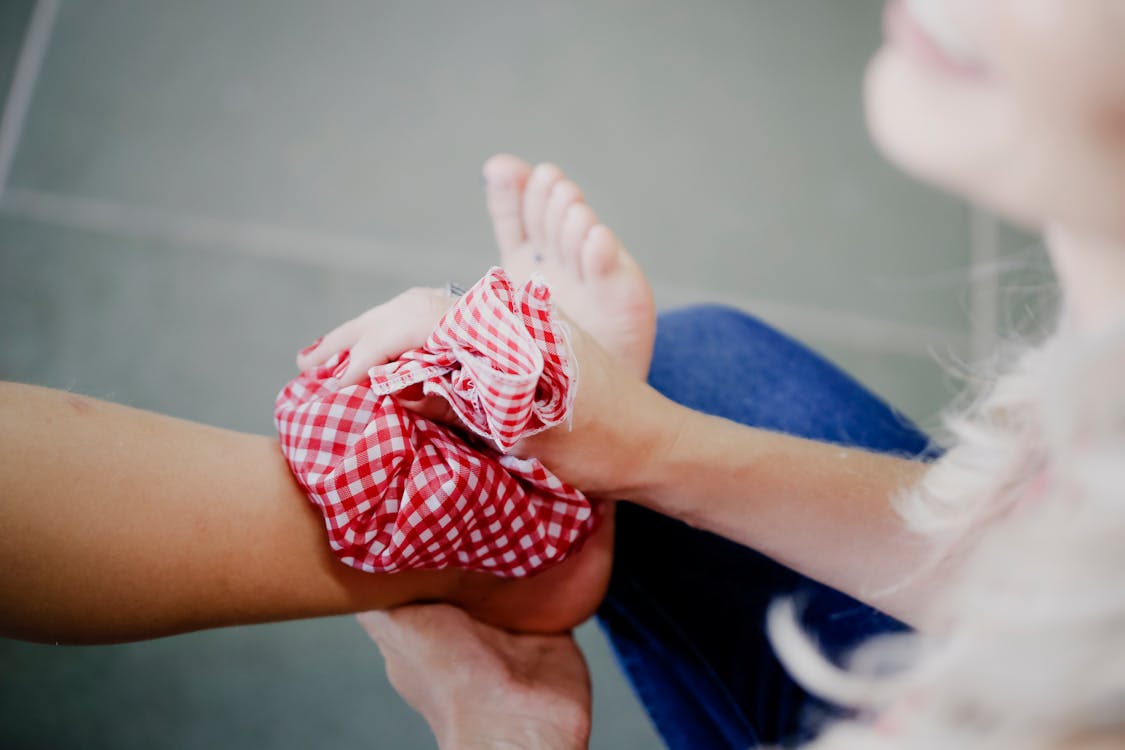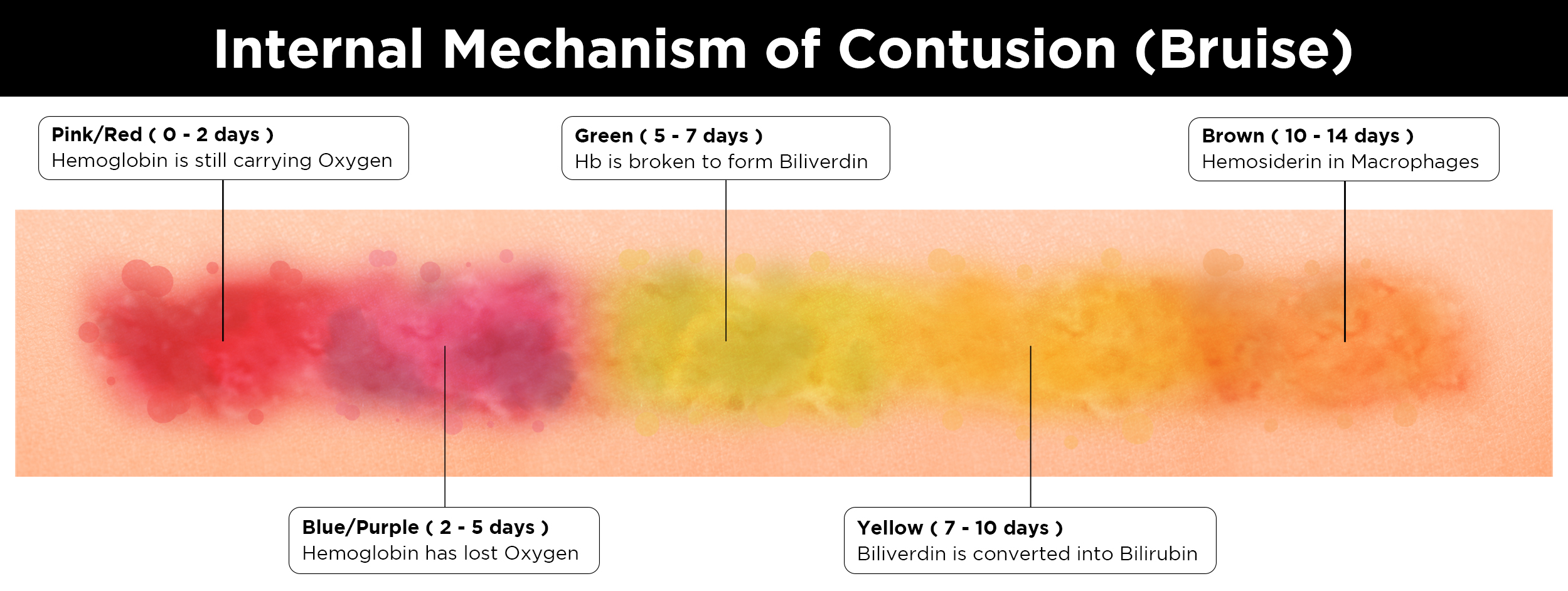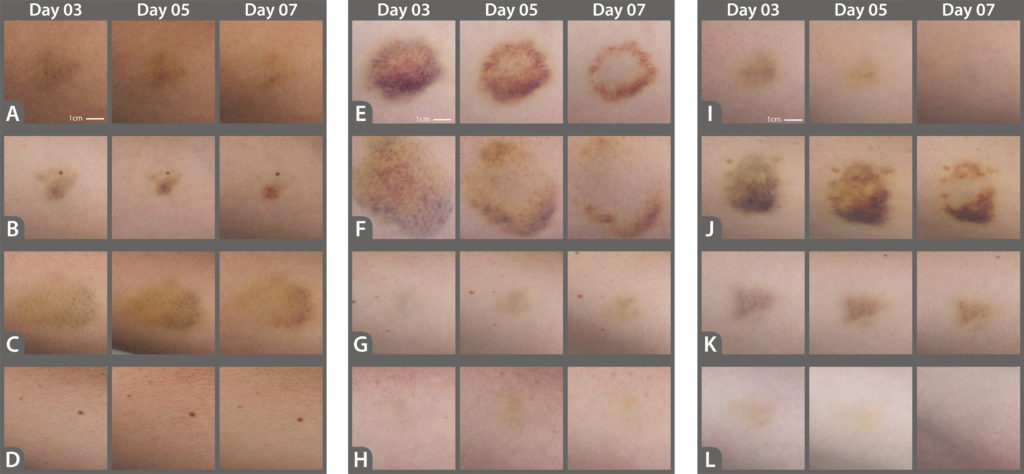101 Series: The Colorful Stages of Skin Bruising
Share

[Reader discretion advised: The article has graphic imagery]
Sometimes life happens, and your knee (or worse, your toe!) runs into the table. Now you’re left with a two-week reminder of your clumsiness: a BRUISE!
A bruise, medically known as ecchymosis, forms when blood is trapped under the skin. It is mainly caused by a blunt-trauma injury causing blood vessels to burst but not break the skin. It’s interesting (and maybe scary!) to think about the number of times we’ve broken blood vessels…it goes to show how fragile our bodies really are! Not only can silly instances, like running into furniture, cause bruising, cupping and hickeys (a.k.a. “love bites”) also create/are bruising.
Bruises come in a variety of colors, from the infamous blue/purple to yellow/brown. But not all bruises are equal… or are they? Do the colors mean anything? Let’s dig a little deeper!

Types of Bruises
There are three different types of bruises: skin, muscle, and bone. Yes, you can bruise your bones, and it’s the most serious of the three, though less severe than a bone fracture. Typically, it takes up to two weeks to fully recover from a bruise but it could be months, depending on the injury, location, and severity.
Unfortunately, there’s not much we can do to help speed up the healing other than applying ice, though the body is very efficient at taking care of it. As the bruise heals, a rainbow of colors appear as the body absorbs the leaked blood. More details on why we see an array of colors below.

The Colorful Stages of Bruises
- Day 1: Pink/Red
- Occurs immediately after the incident
- May be accompanied by swelling and tenderness
- Day 2-6: Blue/Purple
- Low oxygen supplied and swelling at injury site
- Day 7: Pale Green
- Hemoglobin breaks down
- Biliverdin is present (a heme catabolism product), the chemical responsible for the green coloring
- Healing process begins
- Day 8-14: Yellow/Brown
- Inflicted area begins returning to normal skin tone
- Biliverdin is reduced to bilirubin (a product from breaking down hemoglobin), the chemical responsible for the yellowish coloring

Why Do Some People Bruise More Easily Than Others?
There are a few factors. Some people are just born to bruise like a peach…they have unlucky genes. Others may have vitamin C or vitamin K deficiencies, which allow for weaker blood vessels. Lastly, age does matter. Our skin gets thinner and more fragile as we get older, making us more prone to bruising.
A good example comes from a study published in 2013 in the Forensic Science International Journal which evaluated the variation in human bruising responses in a controlled environment. As evident from the picture below, not all humans respond to bruising in the same way. Another important note is that even if a bruise does not form, it does not necessary mean that there has been no trauma inflicted upon the body.
[Reader discretion advised: The remaining article covers a sensitive topic and has graphic imagery]
Sadly, this is very relevant to victims of abuse where skin is often the first place to look for signs of trauma or physical abuse. Simply observing the bruise may not be an absolute predictor about the time or intensity of assault on the body.

Conclusion
No matter how big or small the bruise, they sure can be painful. The body’s ability to combat impact and heal itself time and time again is something truly amazing, isn’t it? Not only does it just heal, the body directly communicates its progress with us through displaying a variety of colors on the skin, and now, we’re in the know of exactly what’s happening at each stage!
If you enjoyed reading this article, you may also like – “Do You Know Your Fitzpatrick Skin Type?“.
References:
- “Bruises.” MedlinePlus, U.S. National Library of Medicine, 29 Mar. 2022 [Link]
- Cover picture by [Link]
- “Ice Pack On Person’s Foot” by Vidal Balielo Jr. via Pexels
- Internal Mechanism of Contusion [Link]
- Lecomte MM, Holmes T, Kay DP, Simons JL, Vintiner SK. The use of photographs to record variation in bruising response in humans. Forensic Sci Int. 2013 Sep 10;231(1-3):213-8. [Link]
- Nash KR, Sheridan DJ. Can one accurately date a bruise? State of the science. J Forensic Nurs. 2009;5(1):31-7. [Link]
- “Swimmer’s Cupping Bruises” photo by David Gray/REUTERS
- Timmons, Jessica. “Why Do My Bruises Have so Many Different Colors?” Healthline, Healthline Media, 10 Mar. 2021, [Link].
If you enjoyed our content, please share, comment, like and follow us on your favorite platforms!
..
.,

